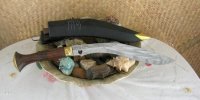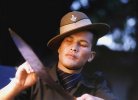Congrats and welcome. Unwrapping your first HI is a blast. Except for the part where you go broke shortly after...
You want to put it to use, but you're gonna have to decide if this is going to be a pretty blade that you show your firends and admire and save for the zombie invasion or if you actually want to use it. Trust me, that's a hard choice. I bought my first because a DOTD called to me but I just didn't know for what. I babied it for awhile, got a couple specifically to be users. Ultimately I ended up with quite a few that I was babying before I took 'em *all* one day and gave them the whack test. That invalidated the warranty on over half of them, but I was tired of not knowing "how tuff" they were or whether the edge was hardened properly. It also introduced a couple hairline cracks to some of the handles. These probably would have happened anyway over time, but the brief "abuse" brought them out. One particularly "small" and decorative knife sustained some major cracking of the wood handle during this process, but there are no missing pieces of wood so it doesn't look too bad. I'll probably epoxy it one day. I think I've got a video of this process somewhere that I should post. After that day I don't mind babying any of my knives and I know them all better and each of them has seen *some* use.
For most of us a 25" knife is not very practical (but make no mistake, I own several). Maybe you could practice some "forms" with the knife (e.g. ala Tai Chi or Karate). You can chop pumpkins or water jugs in half. You can practice your skills by sharpening the blade and adjusting the handle to fit you perfectly. As Karda said, you could take it to 6" bamboo, but be aware, as well-made as HI knives are, they are not light sabers. They will not effortlessly go through a field of large bamboo - and a 25" siru is not the most effective way to take down 6" bamboo. But I bet you would learn a lot about the bamboo plant and your knife in the process. And you would learn a lot about weilding a 25" khukuri that you probably don't already know.
Start small and in private and with softer items (e.g. water bottle, pumpkin, green wood like pine) so you're not trying to impress anyone and you can learn, and above all, be safe.
Or just give it a whack test to get minimal scratches/evidence of use and keep it shiny and as a display blade.
Or skip the whack test and keep it shiny as a display/hand-down-to-future-generations blade.
But I totally recommend you learn to sharpen the blade, adjust the handle and maintain the blade and handle (e.g. oiling). Depending on how much practice you have with sharpening a convex and "bent" edge you may scratch the blade so be careful. Not that the blade minds being scratched, but you may decide that you like it shiny and the shine is hard to restore yourself without the right equipment and training. Also look for the thread from today about brass inlays on sirus.
Safety -> Maintenace -> Normal Use (there really is none predefined for a 25" siru except lopping heads and whatever you find you like to do with it) -> Non-traditional or Extreme Use


